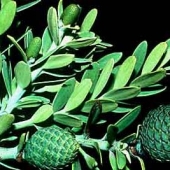Please select root levels for the menu
NZ Plants
Libocedrus plumosa - kawaka, kaikawaka
Cypress family: Cupressaceae
-
Mature foliage
L Jensen
View picture -
Mature foliage
L Jensen
View picture -
Leaves, upper stem surface
I MacDonald
View picture -
Leaves, lower stem surface
L Jensen
View picture -
Leaf lower surface, stomata
L Jensen
View picture -
Seedling plant
L Jensen
View picture -
Juvenile foliage, seedling plant
L Jensen
View picture -
Juvenile foliage with early formation of scale leaves
L Jensen
View picture -
Older seedling with mature foliage
L Jensen
View picture -
Pollen cones
I MacDonald
View picture -
Pollen cone
L Jensen
View picture -
Ovule cones
I MacDonald
View picture -
Young ovule cone with two pairs of bracts. Only the two inner bracts will bear ovules.
L Jensen
View picture -
Large fertile bract
L Jensen
View picture -
Base of fertile bract, a small dome-shaped fertile scale bears two pre-pollination ovules.
L Jensen
View picture -
Fertile bract removed, enlarged fertile scale with pair of post-pollination ovules.
L Jensen
View picture -
Fertile scales join together over the ovules while the bracts (outermost) enlarge and form spines.
L Jensen
View picture -
Cone opened up, bract and fertile scale removed. The seeds develope large, flat wings.
L Jensen
View picture -
As the mature cone dries out, the bracts and fertile scales separate exposing the winged seeds within.
I MacDonald
View picture -
Seed with wing
L Jensen
View picture
Libocedrus plumosa is a tall tree with a pyramidal shape when young and small scale-like leaves that are compressed and flattened to the stem stem into four rows forming a lateral pair and a dorsal-ventral pair. The lateral leaves are much larger than the dorsal and ventral leaves and the ultimate branches are flattened giving a feathery effect to the foliage. Seed cones are small and woody, with a distinctive sharp spine on the outer bracts and release seeds while attached to the tree.
An endemic species found in lowland forest throughout New Zealand.
Vegetative characteristics |
Reproductive characteristics |
|---|---|
Adult plant form: tree up to 25 m |
Pollen and ovule cones: on the same tree |
Adult leaf form: sheathing, triangular, closely overlapping two dorsal/ventral rows |
Pollen cone: 5-8 mm long with 10-14 fertile scales |
Adult leaf size: lateral leaves up to 5mm; dorsal-ventral leaves up to 2.5 mm |
Ovule cone: ovoid, 5-8 mm wide with two sterile and two fertile bracts arranged in opposite pairs; a small fertile cone scale is on the inner surface of each of the two uppermost bracts |
Adult leaf arrangement: in pairs arranged in two lateral rows and two dorsal-ventral rows |
Ovule position: two upright ovules on the upper surface of each fertile cone scale |
Juvenile leaf form: linear, needle-like becoming triangular |
Ovule coverings: a single covering (integument); after fertilisation the ovule is covered by the enlarged fertile scale |
Juvenile leaf size: up to 10 mm |
Ovule pore (micropyle): directed upward |
Juvenile leaf arrangement: spiral, spreading out from the stem becoming in two lateral rows. |
Mature seed cone: spherical and woody, 10-15 mm diam.; curved spine on the back of each woody bract ; up to four winged seeds are released when cone opens |




